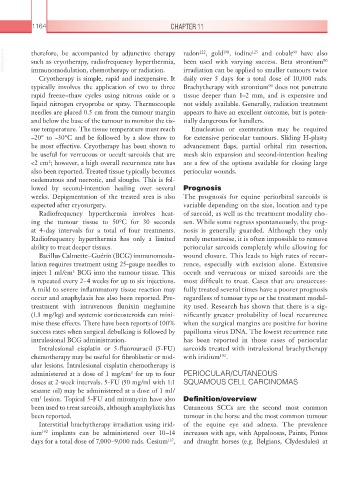Page 1189 - Equine Clinical Medicine, Surgery and Reproduction, 2nd Edition
P. 1189
1164 CHAPTER 11
VetBooks.ir therefore, be accompanied by adjunctive therapy radon , gold , iodine and cobalt have also
222
60
125
198
such as cryotherapy, radiofrequency hyperthermia,
been used with varying success. Beta strontium
90
immunomodulation, chemotherapy or radiation.
Cryotherapy is simple, rapid and inexpensive. It irradiation can be applied to smaller tumours twice
daily over 5 days for a total dose of 10,000 rads.
typically involves the application of two to three Brachytherapy with strontium does not penetrate
90
rapid freeze–thaw cycles using nitrous oxide or a tissue deeper than 1–2 mm, and is expensive and
liquid nitrogen cryoprobe or spray. Thermocouple not widely available. Generally, radiation treatment
needles are placed 0.5 cm from the tumour margin appears to have an excellent outcome, but is poten-
and below the base of the tumour to monitor the tis- tially dangerous for handlers.
sue temperature. The tissue temperature must reach Enucleation or exenteration may be required
−20° to −30°C and be followed by a slow thaw to for extensive periocular tumours. Sliding H-plasty
be most effective. Cryotherapy has been shown to advancement flaps, partial orbital rim resection,
be useful for verrucous or occult sarcoids that are mesh skin expansion and second-intention healing
<2 cm ; however, a high overall recurrence rate has are a few of the options available for closing large
2
also been reported. Treated tissue typically becomes periocular wounds.
oedematous and necrotic, and sloughs. This is fol-
lowed by second-intention healing over several Prognosis
weeks. Depigmentation of the treated area is also The prognosis for equine periorbital sarcoids is
expected after cryosurgery. variable depending on the size, location and type
Radiofrequency hyperthermia involves heat- of sarcoid, as well as the treatment modality cho-
ing the tumour tissue to 50°C for 30 seconds sen. While some regress spontaneously, the prog-
at 4-day intervals for a total of four treatments. nosis is generally guarded. Although they only
Radiofrequency hyperthermia has only a limited rarely metastasise, it is often impossible to remove
ability to treat deeper tissues. periocular sarcoids completely while allowing for
Bacillus Calmette–Guérin (BCG) immunomodu- wound closure. This leads to high rates of recur-
lation requires treatment using 25-gauge needles to rence, especially with excision alone. Extensive
inject 1 ml/cm BCG into the tumour tissue. This occult and verrucous or mixed sarcoids are the
3
is repeated every 2–4 weeks for up to six injections. most difficult to treat. Cases that are unsuccess-
A mild to severe inflammatory tissue reaction may fully treated several times have a poorer prognosis
occur and anaphylaxis has also been reported. Pre- regardless of tumour type or the treatment modal-
treatment with intravenous flunixin meglumine ity used. Research has shown that there is a sig-
(1.1 mg/kg) and systemic corticosteroids can mini- nificantly greater probability of local recurrence
mise these effects. There have been reports of 100% when the surgical margins are positive for bovine
success rates when surgical debulking is followed by papilloma virus DNA. The lowest recurrence rate
intralesional BCG administration. has been reported in those cases of periocular
Intralesional cisplatin or 5-fluorouracil (5-FU) sarcoids treated with intralesional brachytherapy
chemotherapy may be useful for fibroblastic or nod- with iridium .
192
ular lesions. Intralesional cisplatin chemotherapy is
administered at a dose of 1 mg/cm for up to four PERIOCULAR/CUTANEOUS
3
doses at 2-week intervals. 5-FU (50 mg/ml with 1:1 SQUAMOUS CELL CARCINOMAS
sesame oil) may be administered at a dose of 1 ml/
cm lesion. Topical 5-FU and mitomycin have also Definition/overview
3
been used to treat sarcoids, although anaphylaxis has Cutaneous SCCs are the second most common
been reported. tumour in the horse and the most common tumour
Interstitial brachytherapy irradiation using irid- of the equine eye and adnexa. The prevalence
ium implants can be administered over 10–14 increases with age, with Appaloosas, Paints, Pintos
192
days for a total dose of 7,000–9,000 rads. Cesium , and draught horses (e.g. Belgians, Clydesdales) at
137

